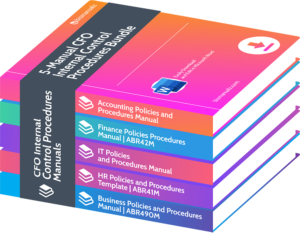What are CFO Financial Performance Metrics?

Do you want to enhance your financial performance skills and stay ahead of the competition? This article is for you. As the financial landscape becomes more complex, it is crucial for CFOs to understand and utilize key performance metrics to drive success. What are CFO financial performance metrics?
Why Are Financial Performance Metrics Important for a CFO?
As a CFO, understanding and utilizing financial performance metrics is crucial for effectively managing a company’s financial health. These metrics not only provide a snapshot of the company’s current financial state, but also offer valuable insights for future decision making.
In this section, we will delve into the importance of financial performance metrics for a CFO, including how they help monitor the company’s financial health, provide insights for decision making, and identify areas for improvement.
1. Helps Monitor Company’s Financial Health
Monitoring a company’s financial health is crucial for a CFO. Here are steps to effectively monitor a company’s financial health:
- Regularly review financial statements to assess overall performance and stay informed about the company’s financial health.
- Analyze key financial ratios like liquidity, solvency, and profitability to gain insight into the company’s financial standing.
- Compare financial results with industry benchmarks and competitor performance to understand the company’s position in the market.
- Identify trends and patterns in financial data to pinpoint strengths and weaknesses within the company.
- Conduct variance analysis to understand deviations from budgeted financials and make necessary adjustments.
- Utilize financial forecasting models to predict future performance and make informed decisions.
- Implement a robust internal control system to ensure accuracy and reliability of financial information and maintain the company’s financial health.
- Engage with external auditors to obtain an independent assessment of the company’s financial health and identify potential areas for improvement.
By following these steps, a CFO can effectively monitor the company’s financial health and use data-driven insights to make informed decisions to improve performance.
2. Provides Insights for Decision Making
Financial performance metrics are crucial for CFOs as they provide valuable insights for decision making. Here are steps on how to effectively utilize these metrics:
- Identify relevant metrics: Determine which financial performance metrics are most relevant to your company’s goals and industry, providing insights for decision making.
- Collect and analyze data: Gather accurate and up-to-date financial data to calculate the chosen metrics. Analyze the results to gain insights into the company’s financial performance.
- Compare against benchmarks: Compare the calculated metrics against industry benchmarks or historical data to gauge the company’s performance relative to its peers, providing insights for decision making.
- Identify strengths and weaknesses: Use the insights gained from the metrics to identify areas where the company is excelling and areas that require improvement, providing insights for decision making.
- Inform decision making: Utilize the insights provided by the metrics to make informed decisions regarding resource allocation, investment opportunities, cost-cutting measures, and strategic initiatives, providing insights for decision making.
- Monitor progress: Continuously monitor the chosen metrics to track the impact of decisions and initiatives on the company’s financial performance, providing insights for decision making.
3. Helps Identify Areas for Improvement
Identifying areas for improvement is a crucial aspect of utilizing financial performance metrics for a CFO. This can be achieved through the following steps:
- Analyze key financial performance metrics or KPIs such as revenue growth, profit margins, return on investment, cash flow, debt-to-equity ratio, and working capital.
- Compare the metrics against industry benchmarks or historical data to identify any deviations or underperformance.
- Conduct a thorough review of financial statements, budgeting processes, and operational procedures to pinpoint specific areas that require improvement.
- Collaborate with relevant departments to gather insights and suggestions for enhancing performance in the identified areas.
- Develop and implement strategies to address the identified weaknesses, focusing on efficiency, cost reduction, revenue enhancement, and risk management.
- Regularly monitor and reassess the impact of implemented measures to ensure progress and track improvement over time.
By following these steps, a CFO can effectively utilize financial performance metrics to identify areas for improvement and drive the overall success of the company.
What Are the Key CFO Financial Performance Metrics?
As a CFO, understanding and monitoring financial performance is crucial for the success of a company. In this section, we will discuss the key financial performance metrics that a CFO should be familiar with in order to make informed decisions and drive the company towards growth.
From revenue growth and profit margins to return on investment and debt-to-equity ratio, we will delve into the important numbers that can accurately reflect the financial health of a company. Additionally, we will also touch on the significance of working capital and its impact on overall financial performance.
1. Revenue Growth
Revenue growth is a crucial financial performance metric for a CFO as it indicates the company’s ability to generate more income over time. To effectively measure and improve revenue growth, CFOs should:
- Analyze historical revenue data and identify growth patterns.
- Set realistic revenue growth goals based on market conditions and company capabilities.
- Implement strategies to increase sales, such as expanding into new markets or launching new products.
- Regularly monitor and track revenue performance against targets to identify any deviations.
- Adjust strategies and tactics as needed to optimize revenue growth.
A fact: According to a study, companies with a consistent revenue growth rate of 20% or more are more likely to be profitable in the long term.
2. Profit Margins
Profit margins are a crucial financial performance metric that should be considered by a CFO. To analyze and improve profit margins, follow these steps:
- Calculate profit margins: Divide net income by total revenue and multiply by 100 to get the percentage.
- Compare with industry benchmarks: Assess if the profit margins align with those of competitors in the industry.
- Analyze cost structure: Identify areas where costs can be reduced, such as operational expenses or production costs.
- Review pricing strategy: Evaluate if prices are appropriately set to maximize profitability.
- Optimize product mix: Focus on higher-margin products or services to increase overall profit margins.
- Monitor and adjust regularly: Continuously track and analyze profit margins to identify trends and make necessary adjustments.
3. Return on Investment
Return on Investment (ROI) is a crucial financial performance metric for a CFO. To effectively utilize ROI for improving company performance, the following steps can be taken:
- Calculate ROI: Determine the ROI by dividing the net profit from an investment by the total cost of the investment.
- Set ROI Goals: Establish realistic ROI targets based on industry benchmarks and company objectives.
- Analyze Investment Performance: Regularly review and analyze the ROI of different investments to identify areas with high or low ROI.
- Identify Improvement Opportunities: Identify investments with low ROI and explore strategies to improve their performance.
- Implement Optimization Strategies: Implement cost-cutting measures, operational improvements, or strategic changes to enhance ROI.
4. Cash Flow
Cash flow is a critical financial performance metric for a CFO. Here are steps to effectively manage cash flow:
- Track cash inflows and outflows: Monitor incoming and outgoing cash to understand the overall cash position.
- Forecast cash flow: Predict future cash inflows and outflows based on historical data and business projections.
- Manage accounts receivable: Ensure timely collection of payments from customers to maintain a healthy cash flow.
- Control expenses: Analyze and reduce unnecessary expenses to improve cash flow.
- Optimize inventory management: Avoid excessive inventory to free up cash and reduce storage costs.
- Negotiate favorable payment terms: Work with suppliers to extend payment terms and improve cash flow.
- Utilize cash flow management tools: Implement software or systems that automate cash flow tracking and reporting.
5. Debt-to-Equity Ratio
The debt-to-equity ratio is a key financial performance metric for CFOs to assess a company’s financial stability and leverage. Here are the steps to effectively use this metric:
- Calculate the debt-to-equity ratio by dividing the total debt by the total equity.
- Analyze the ratio to determine the company’s financial risk. Higher ratios indicate higher leverage and potential difficulties with repayment.
- Compare the ratio with industry benchmarks and competitors to evaluate the company’s financial position.
- Identify trends in the ratio over time to monitor changes in the company’s capital structure and financial health.
- Develop strategies to optimize the debt-to-equity ratio, such as reducing debt, increasing equity, or refinancing existing debt.
- Regularly review and update the ratio to track progress and make informed financial decisions.
6. Working Capital
Working capital is a crucial financial performance metric for a CFO, as it measures a company’s ability to cover its short-term obligations. To effectively manage working capital, CFOs should follow these steps:
- Analyze current working capital status, including cash, inventory, and accounts receivable.
- Identify areas of improvement, such as reducing inventory levels or tightening credit policies.
- Implement strategies to optimize working capital, like negotiating better payment terms with suppliers.
- Regularly monitor and analyze working capital ratios to ensure ongoing improvement.
By effectively managing working capital, CFOs can improve cash flow, enhance financial stability, and support overall company performance.
How to Use Financial Performance Metrics to Improve Company Performance?
As a CFO, understanding business metrics is crucial for effectively managing and improving a company’s performance. In this section, we will discuss how to use financial performance metrics to drive growth and success for your organization.
From setting realistic goals to implementing strategies for improvement, these metrics can provide valuable insights into the financial health of your company and guide decision making. Let’s dive into the key steps for utilizing financial performance metrics to their full potential.
1. Set Realistic Goals
Setting realistic goals is crucial for a CFO in improving the company’s financial performance. Here are the steps to follow:
- Evaluate the current financial state of the company.
- Consider the company’s strengths and weaknesses.
- Analyze industry trends and benchmarks.
- Identify areas that need improvement.
- Set specific, measurable, attainable, relevant, and time-bound (SMART) goals.
- Communicate these goals to the team.
- Create a plan with actionable steps.
- Monitor progress regularly and make adjustments as needed.
By setting realistic goals, the CFO can guide the company towards success and ensure that financial performance metrics are aligned with strategic objectives.
2. Regularly Monitor and Analyze Metrics
Regularly monitoring and analyzing financial performance metrics is crucial for a CFO to ensure the company’s financial health and make informed decisions. Here are the steps to effectively monitor and analyze metrics:
- Establish a regular monitoring schedule to track key metrics.
- Collect accurate and reliable data for each metric.
- Analyze the trends and patterns in the metrics to identify any anomalies or areas of concern.
- Compare the metrics against industry benchmarks or historical data to gain insights into the company’s performance.
- Conduct in-depth analysis to understand the underlying factors influencing the metrics.
- Present the findings to the CFO and other relevant stakeholders.
- Identify any necessary adjustments or corrective measures based on the analysis.
- Implement strategies to improve performance in areas identified as needing improvement.
By regularly monitoring and analyzing metrics, the CFO can proactively identify opportunities for improvement and drive the company towards financial success.
3. Identify Areas for Improvement
Identifying areas for improvement is a crucial step in utilizing financial performance metrics to enhance company performance. Here are steps to consider:
- Review financial statements and metrics to identify areas with underperformance or negative trends.
- Conduct a thorough analysis of the identified areas, investigating root causes and potential solutions.
- Engage with relevant stakeholders, including department heads, to gather insights and perspectives on the identified areas.
- Set specific and measurable goals for improvement in the identified areas, aligning them with overall company objectives.
- Develop strategies and action plans to address the identified areas, assigning responsibilities and timelines.
- Regularly monitor and track progress using the chosen financial performance metrics, making adjustments as necessary.
- Communicate progress and results to stakeholders, fostering transparency and accountability throughout the improvement process.
By following these steps, a CFO can effectively identify areas for improvement and implement strategies to enhance company performance.
4. Implement Strategies to Improve Performance
To enhance company performance, CFOs can utilize strategies based on financial performance metrics. Here are some steps to follow:
- Set clear and specific goals for improvement.
- Regularly monitor and analyze the chosen metrics to track progress.
- Identify areas for improvement by identifying trends and patterns in the data.
- Develop and implement strategies tailored to address the identified areas.
By following these steps, CFOs can effectively implement strategies to improve performance and drive positive change within the company. It is important to remember that careful planning and execution are crucial in achieving success.
Frequently Asked Questions

What should a CFO Know about Financial Performance Metrics?
A CFO should have a deep understanding of financial performance metrics in order to effectively manage and improve the financial health of the company.
What are financial performance metrics?
Financial performance metrics are numerical indicators that measure the financial health and success of a company, such as profitability, liquidity, and efficiency.
Why are financial performance metrics important?
Financial performance metrics provide valuable insights into the financial health and success of a company. They help a CFO make data-driven decisions and track progress towards financial goals.
What are some examples of financial performance metrics?
Examples of financial performance metrics include return on investment (ROI), gross profit margin, current ratio, and debt-to-equity ratio.
How does a CFO use financial performance metrics?
A CFO uses financial performance metrics to monitor the company’s financial performance, identify areas for improvement, make strategic decisions, and communicate financial information to stakeholders.
What are some best practices for using financial performance metrics?
Some best practices for using financial performance metrics include selecting relevant metrics for the company’s industry and goals, setting achievable targets, regularly reviewing and analyzing the metrics, and using them to drive action and improvement.
















Leave a Reply